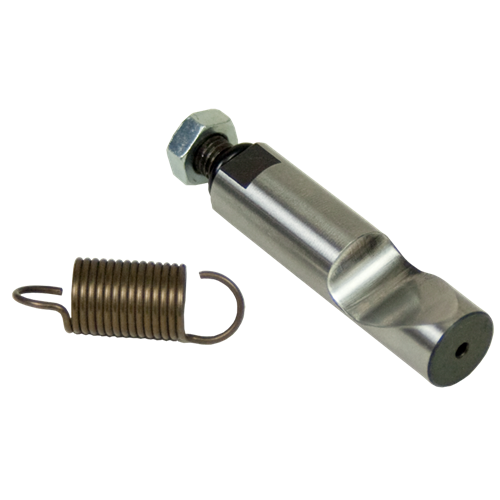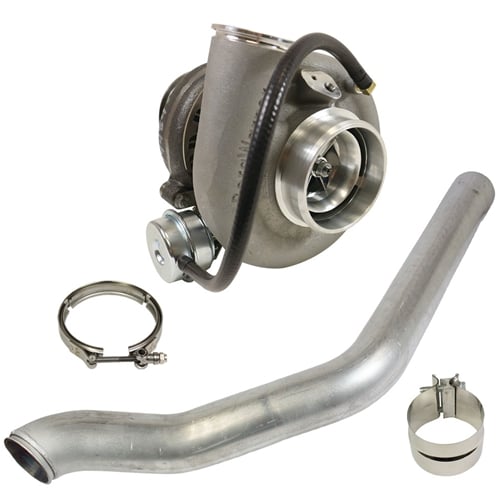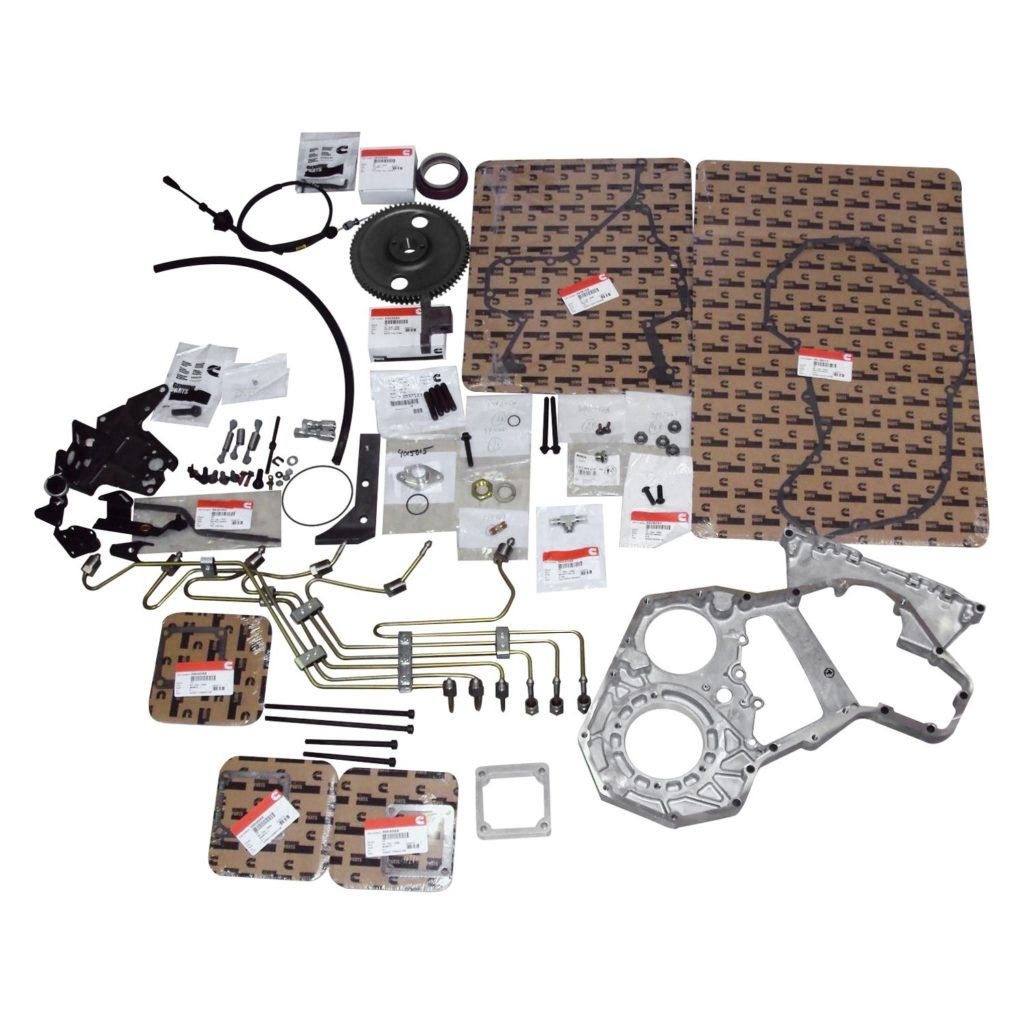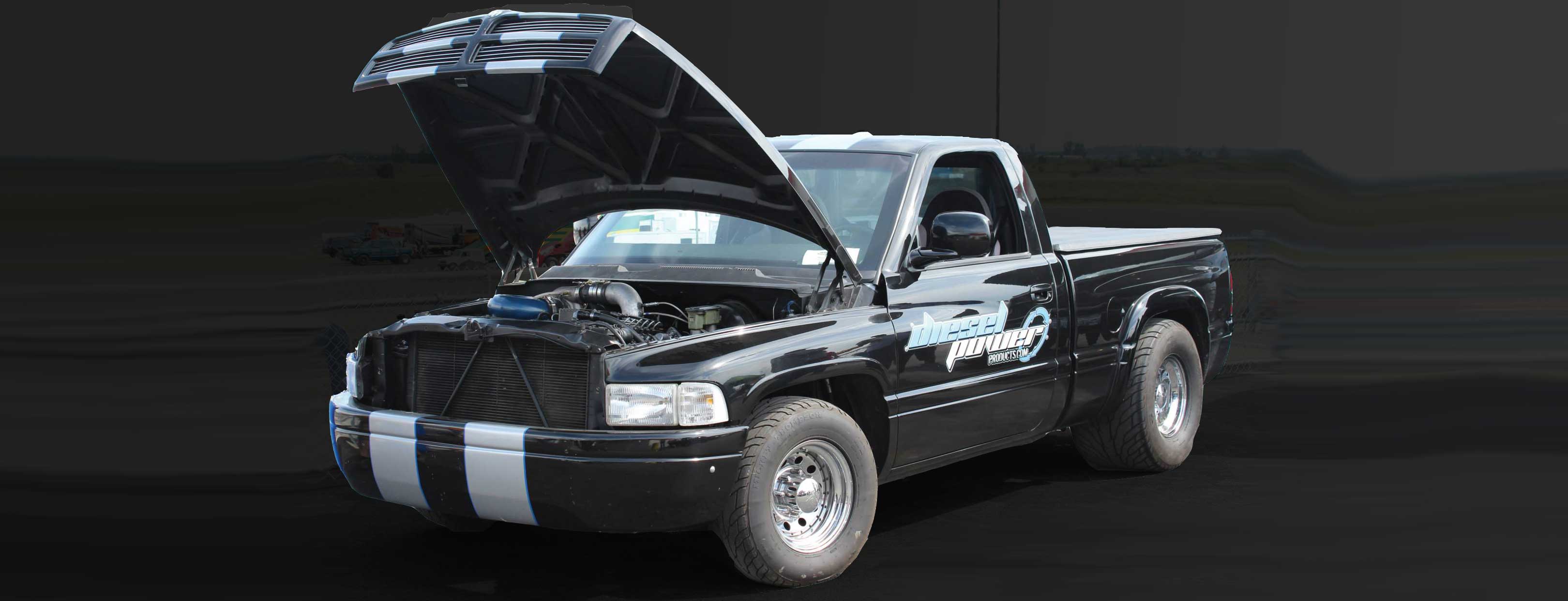High performance diesel trucks are more popular than ever, and with advances in turbochargers, tuning, and high-pressure injection, it’s possible to have a fuel efficient high-powered daily driver that can still tow and blast down the quarter mile. Common rails have been popular for some time now, but they’re far from the original high-performance diesel powerplant. That distinction goes to a mechanical marvel of the mid 90s known as the 6BT Cummins.
When they left the factory, the 6BT had a horsepower rating somewhere between 160 and 215 horsepower, and the torque figures came in between 400 and 440 lb.ft. While that’s pretty dismal by today’s standards considering the 2019 HO Cummins is rated at 1,000lb.ft., back in the mid 90’s, that was a very competitive rating. Low power numbers aside, the 12-valve is a very solid engine. The 100% mechanical design requires no electronic intervention to run other than a starter motor, and the design is so well sorted out they will run forever with nothing more than basic maintenance, and they are very simple to work on. If you were able to find a bone stock truck and put it on a chassis dyno today, it would put down somewhere around 150hp to the rear wheels. When it comes to adding power, the stock internals are way overbuilt for how much power they came with, and it’s not uncommon to make 700 horsepower or more on the stock pistons, rods, and crank.
If you show up at a diesel event today, you’re guaranteed to find at least a couple of old 12-valves still spooling their turbos. The trucks they’re installed in are very inexpensive to buy compared to their modern counterparts, performance parts are cheap, and the 2nd gen Rams are pretty light which makes them a great entry level racing platform. While that’s all great news, it does take a few carefully planned steps to reach a higher horsepower goal.
Starting at the Bottom
To add performance to any diesel, the steps are the same regardless of how old or new it is. You need to push more air and fuel into the engine to add the power and then strengthen a few areas to contain the extra heat and pressure which you create. Right off the bat, a free-flowing 4” exhaust will allow more airflow out of the engine and give it a tougher sounding exhaust note. If you don’t want to spend a ton of money, then an MBRP aluminized turbo back single exhaust will get the job done and leave some change in your pocket for future mods. It will connect to the factory turbo and hangers for an easy install, and even if you opt for the muffler and stainless tip, it still comes out to less than $375. On the opposite end of the turbo we need to let more air into the compressor housing, so an intake from S&B can be thrown on which moves almost 40% more air than stock, plus the filter is isolated from engine bay heat so it’s truly a “cold air” intake. Remember: cold and dense air is always the goal.
There will be two separate injection pumps we’re talking about today, the earlier VE rotary style which was used between ’89 and ’93, and the later P7100 which was used from ’94 to ’98, and both are very easy to modify to deliver more fuel. Regardless of which style of pump you have, it needs two basic changes at first: 1) the governor RPM needs to be raised to allow the engine to spin faster, and 2) the fuel rate needs to be modified to allow more diesel into the engine. On a VE pump, this is accomplished with a BD Fuel Pin & Governor Spring Kit which has everything you need under one part number, and adds 40 horsepower and 90lb.ft. or torque, and the best part is it installs in about 2 to 3 hours and costs only $164.

If you’re rocking the more popular P-Pump version of the 12-valve, the power is controlled by the shape of a flat piece of metal called the fuel plate. While you can buy several different profiles or even grind your stock plate to the desired shape, a better option would be to install a Dynomite Diesel Adjustable Fuel Plate. This will add anywhere from 25 to 140 additional horsepower, and you can simply adjust it to grow with your changing fueling requirements. And if for any reason you need to lower fuel output, you can do that as well. To compliment the increased fuel delivery, you also need to raise the RPM range of the engine with a governor spring kit from PacBrake. The stock spring will defuel the truck around 2,700 RPM which puts the engine way below its peak power after a gear shift, so the higher RPM springs will help keep the engine where it wants to be. Combine those inexpensive parts with a few careful adjustments to the AFC housing, fuel rack star wheel, and a deeper rack plug, and you’ll have approximately another 80 horsepower. But that’s just where things are getting started.
Middle of the Road
Once the inexpensive upgrades are done, you’ll be making somewhere around the 250hp to the wheels, but there is still room for improvement. You do have to make a few decisions about the next stage however: if you want to max out the stock turbo and call it a day, adding a set of BD-Power 45hp injectors should get you close to that magic 300hp figure, which will double your stock horsepower. However, if you want to push further, it doesn’t make sense to stop halfway, so I would start thinking about your final power goal and select an injector that matches. Dynomite Diesel offers Stage 1, 2, or 3 injectors which can support 400, 500, or 700 horsepower respectively. When driven conservatively, a set of larger injectors can even deliver an increase in fuel mileage, and you will have to advance the injection timing a bit to suit the size of your new sticks.
You would however be a fool to modify your pump and install some massive injectors but leave your stock turbo in place. Take my word for it, you will have a smoky, high temperature engine which is no fun to drive. You need to match the increased fuel delivery with an increase in air with a larger turbocharger. It is extra critical you select the correct size turbo on a 12-valve truck, since the mechanical injection pump has static timing and no variable vanes in the exhaust housing. The stock specs for a 12-valve Holset HX35 will vary from year to year and whether the truck was a manual or auto, but the compressor inducer will be between 54 and 56mm. While popular upgrades for common rail trucks range between 64 and 67mm, a hot street 12-valve 5.9 needs to be a bit smaller. If the 500hp mark is what your sights are set on, the Super B Killer SX-E turbo kit is the ideal size, with a 61mm compressor wheel, and a tight 0.80 A/R ratio on the turbine housing. The turbocharger utilizes a wastegate just like the stock unit, so it is protected from overspeed and high drive pressure and will spool very quickly for its size.

Along with the larger turbocharger, it will be wise to change a few more parts on the airflow side, starting with the intercooler and then moving along to the intake horn. If you have a 1st gen with no intercooler, you’ll have to do some custom fab work to get one mounted behind the grille, but for the 2nd gen crowd, the AFE Bladerunner fits all 1994-2002 Rams. It’s 25% larger than the stock intercooler, and will withstand up to 100psi of boost, so the air coming from your turbo will be nice and cool by the time it makes its way up to the engine. Mounted to the driver’s side of the cylinder head, the stock intake manifold is very restrictive and only has a single opening, but the Banks TwinRam Intake has a larger port on the front and back of the cylinder head for double the area of the stock manifold, and even air distribution, which means more consistent temps across all cylinders, a longer lasting engine, and everybody’s favorite combination; more horsepower and fuel mileage.
Finally, we need to address the flow between the exhaust port and the turbocharger, and that means a new exhaust manifold. The stock piece is prone to cracking and has very small internal passages, so a freer flowing BD Pulse 3-piece Exhaust Manifold is made from a stronger alloy which will prevent cracks from forming, and the ports are much less restrictive which leads to lower drive pressure and lower EGT, and of course, more power.
Call in the Troops
Once you start to push the horsepower levels toward the extreme, it becomes necessary to do a few reinforcements underneath the valve covers to keep the parts where they belong. You’ve heard dozens of times the benefits of valvesprings and studs on a Cummins, and the 12-valve is no different. Stronger ARP 2000 Head Studs will keep the gasket clamped firmly between the block and the head to seal the combustion pressure inside, and Hamilton Springs will keep the valves opening and closing when they’re supposed to, which is especially important if you go over 30 pounds of boost and 3,500 RPM, both of which you can easily exceed.
If you are familiar with modifying a gas engine, you know one of the first things guys will change out is the camshaft. It’s responsible for opening and closing the valves at the correct time, and an aftermarket cam will hold the valves open longer and open them further, letting more air into the engine, and adding more power. The same holds true with a diesel engine, especially the 12-valve. It can benefit from a larger cam, and the one name to turn to is Hamilton. They make a wide range of camshafts and valvetrain parts for all Cummins engines, and there are several cam profiles to choose from, but just like with a gas engine, the cam you select needs to match your desired usage. For an all-around truck that spends time on the street, the track, and hauls a trailer once in a while, the Hamilton 184/214 offers the best of both worlds: an increase of torque in the midrange and more responsive turbo spool-up, but also a bump in high RPM horsepower as well, and this means an exciting truck to drive that also gets better fuel mileage.
24-Valve Notes
Midway through 1998, Dodge introduced a new engine into their pickups, and it was vastly different from the mechanical 12-valve which preceded it. The 5.9 now had 24 valves and fueling was controlled by the electronic Bosch VP44 injection pump and a computer mounted to the side of the block. This new pump had the ability to dynamically vary injection timing for a wider torque curve and was the grandfather to modern common-rail injection. From a performance standpoint, this delivered more flexibility for tuning, and higher initial power gains before you needed to touch a wrench, however, from an all-out racing standpoint, the earlier P7100 pump still holds the crown.
Just like with the older 12-valve, the 24-valve needs help in the induction and exhaust department, and since the engines are similar, most of the parts selection can overlap, like the size of the turbocharger, injectors, cam, intercooler, and more. You will still need head studs and valvesprings (just more of them), but the main difference in building a 24-valve is tuning and the pump. With a P7100, there are many user serviceable parts which can be changed to add horsepower, but on the VP44, there’s nothing you can easily swap out to add power. Industrial Injection can modify a VP internally and increase the output of the pump. They’ve created the legendary HotRod VP44 Pump which will add another 80-100 horsepower at the rear wheels over the stock pump, and of course when you combine the pump with larger injectors and tuning, the gains will be even greater. While on the topic of fuel, don’t forget about the importance of a quality lift pump on the 24-valve, since the faulty stock electric lift pump has caused the failure of many VP44s. The FASS Titanium Signature Series is a much more reliable replacement which will also clean the fuel better and remove water and air, plus it will never leave you stranded.
The final piece of the puzzle on a VP truck is the calibration of the fueling, and things aren’t as simple as with a common rail truck; if you’ve heard of the term “stacking” it’s likely been in the context of a 24-valve Cummins. The Smarty S03 is a flash programmer and is great place to start. It can get inside the computer and modify the calibration for fueling and boost, and you can customize the settings to suit your tastes with 10 different levels from daily driving, to fuel mileage, to all out performance. This will make the truck more responsive and fun to drive, but if you want to get the absolute most power out of your 24-valve, you need to add an in-line tuner that taps into the injection pump like the Edge Comp Box. With both an inline tuner and a re-flash stacked together, you will have a fire breathing monster. Just make sure to keep the Smarty on a setting which doesn’t add injection timing, since the Edge does, and that is the one parameter you don’t want to double up on.
Hybrid
One of the best attributes of the 24-valve is the higher flowing cylinder head, and as we know more air in and out means more power, but the pump does have its limits. The highest powered VP trucks are somewhere around 700 horses, so if you’re stuck wanting more power but aren’t ready to make the leap forward to common rail, you might consider going back in time and stealing a few parts from the 12-valve to make a hybrid P-pumped 24-valve. It combines the best parts of the newer engine with the reliability and insane horsepower capability of the P7100 and mashes them together to create the ultimate pre-common rail Cummins. It does take a lot of wrench turning, but the Industrial Injection P-pump conversion kit takes all the guesswork out of the equation by offering all the parts needed (minus the pump) underneath one part number.

There is one last airflow modification which we haven’t yet talked about, and that’s compound turbos. They can be installed on any year Cummins, and work by combining both a small responsive charger with a larger higher flowing turbo for a much wider powerband than any single turbo could deliver by iteself, and the best part is how well they control EGT under towing or performance driving conditions. The BD Tow and Track Compound Kit combines a 64mm S300 high-pressure charger with a 74mm S400 low pressure unit for a total airflow of 107 pounds/minute which can support up to 850 horsepower while remaining cool as a cucumber.
Why Wouldn’t You Want One
If you are worried about an impending EMP attack taking out all the electronics in the entire world, a 12-valve Cummins might be the rig for you considering it can be run entirely without any form of electricity as long as you can get it started. For more practical individuals, it can also be daily driven and get excellent fuel economy, haul a trailer, and have fun at the races, plus there are more performance parts available for it than nearly any other diesel. Granted, the trucks are at least 20 years old by now and are likely worse for wear on the cosmetics and chassis side, but it’s nothing a little elbow grease can’t fix. At the end of the day, there’s nothing that beats the sound and feeling of an old-school diesel, and driving that old rig just means you’re saving a ton of money every month from not having a banknote, and that’s just more money you can spend on the go fast goodies. That is a proposition I can support.


I am new to the diesel engines but have owned my 98 model 12 valve w/p7100 and 215 hp from the beginning until now ,and would like to thank you for information that works and a web site that will help the old timers like me. Industrial injection and big bear engines are a few of the people i have considered using.any other suggestions would be appreciated. Thanks Shelby.
thank-you its the info i was looking for